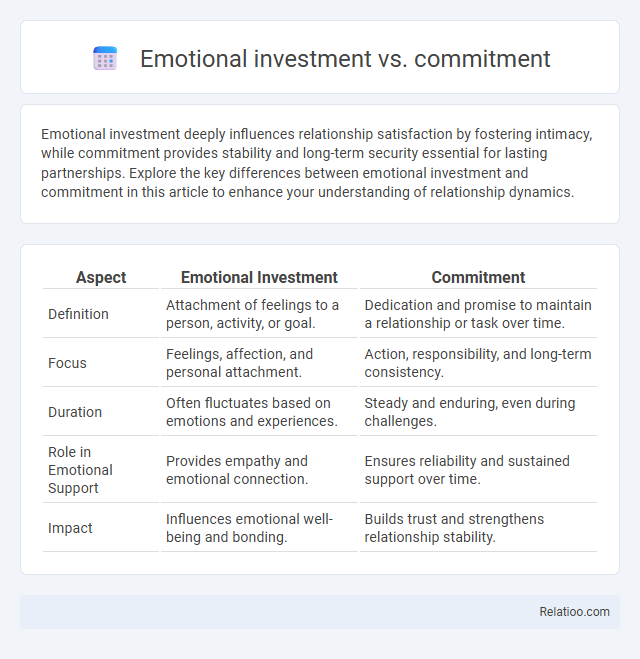Emotional investment deeply influences relationship satisfaction by fostering intimacy, while commitment provides stability and long-term security essential for lasting partnerships. Explore the key differences between emotional investment and commitment in this article to enhance your understanding of relationship dynamics.
Table of Comparison
| Aspect | Emotional Investment | Commitment |
|---|---|---|
| Definition | Attachment of feelings to a person, activity, or goal. | Dedication and promise to maintain a relationship or task over time. |
| Focus | Feelings, affection, and personal attachment. | Action, responsibility, and long-term consistency. |
| Duration | Often fluctuates based on emotions and experiences. | Steady and enduring, even during challenges. |
| Role in Emotional Support | Provides empathy and emotional connection. | Ensures reliability and sustained support over time. |
| Impact | Influences emotional well-being and bonding. | Builds trust and strengthens relationship stability. |
Understanding Emotional Investment
Understanding emotional investment involves recognizing the deep psychological attachment one forms towards a person, goal, or activity, which influences motivation and resilience. Unlike commitment, which is a deliberate decision or promise to maintain a course of action, emotional investment reflects the intensity of feelings and personal stakes involved. This investment can enhance engagement and satisfaction but may also lead to vulnerability if outcomes are unfavorable.
Defining Commitment in Relationships
Commitment in relationships refers to a conscious decision to maintain a long-term bond, often characterized by loyalty, trust, and a mutual sense of responsibility. Unlike emotional investment, which involves feelings and attachments that can fluctuate, commitment represents a deliberate choice to prioritize the relationship's stability and growth. Understanding commitment as a foundation helps partners navigate challenges, fostering resilience beyond transient emotional states.
Key Differences Between Emotional Investment and Commitment
Emotional investment refers to the personal feelings and attachment one develops toward a person, project, or goal, whereas commitment signifies a conscious decision to remain dedicated and uphold responsibilities regardless of emotional fluctuations. Key differences include emotional investment being driven by affective bonds and subjective experience, while commitment involves a deliberate, rational pledge or obligation often linked to long-term goals. Emotional investment can fluctuate with feelings, but commitment persists through challenges, underscoring the distinction between feeling involved and choosing to stay consistently engaged.
Signs of High Emotional Investment
High emotional investment manifests through intense feelings of attachment, frequent thoughts about the relationship, and prioritizing your partner's needs above your own. Signs include eagerness to resolve conflicts, consistent emotional availability, and deep empathy for your partner's experiences. Understanding these indicators helps you distinguish between mere commitment and genuine emotional involvement.
Indicators of Genuine Commitment
Indicators of genuine commitment include consistent actions that align with expressed intentions, long-term prioritization of the relationship, and resilience during conflicts or challenges. Emotional investment reflects the depth of feelings and attachment, while commitment embodies deliberate choices to maintain and nurture the connection over time. Monitoring these indicators helps differentiate between fleeting emotional involvement and steadfast commitment in interpersonal dynamics.
Emotional Investment: Pros and Cons
Emotional investment involves deeply caring about a person or goal, which can enhance your relationships and personal fulfillment by fostering trust and empathy. However, over-investing emotionally may lead to vulnerability, disappointment, and emotional exhaustion if expectations are not met or if the commitment is unreciprocated. Balancing your emotional investment with clear boundaries ensures it remains a positive force without overwhelming your well-being.
Commitment: Benefits and Challenges
Commitment enhances relationship stability by fostering trust and long-term security, enabling you to build deeper connections and shared goals. The benefits include increased emotional resilience, mutual support, and a clear sense of direction within partnerships. Challenges involve managing expectations, balancing personal growth with collective needs, and navigating conflicts without compromising the commitment's integrity.
How Emotional Investment Impacts Relationships
Emotional investment significantly influences the depth and quality of your relationships by fostering trust, empathy, and mutual understanding. Unlike mere commitment, which implies a formal or practical pledge, emotional investment involves actively engaging your feelings and vulnerability, creating stronger emotional bonds. High emotional investment can enhance relationship satisfaction but may also lead to greater pain if issues arise, underscoring the importance of balancing emotional involvement with healthy boundaries.
Balancing Emotional Investment and Commitment
Balancing emotional investment and commitment requires understanding that emotional investment involves feelings and attachment, while commitment reflects a deliberate decision to maintain a relationship or goal. Excessive emotional investment without commitment can lead to disappointment, whereas strong commitment without emotional connection may cause detachment. Optimal balance promotes relationship stability and personal well-being by aligning heartfelt engagement with consistent dedication.
Nurturing Healthy Connections: Practical Tips
Emotional investment requires consistently expressing empathy and understanding to deepen bonds, while commitment involves dedicating time and effort to uphold trust and reliability in relationships. Nurturing healthy connections demands clear communication, active listening, and mutual respect to balance emotional involvement and responsibility. Implementing practices like setting boundaries and prioritizing quality interactions fosters sustained emotional well-being and relationship resilience.

Infographic: Emotional investment vs Commitment
 relatioo.com
relatioo.com